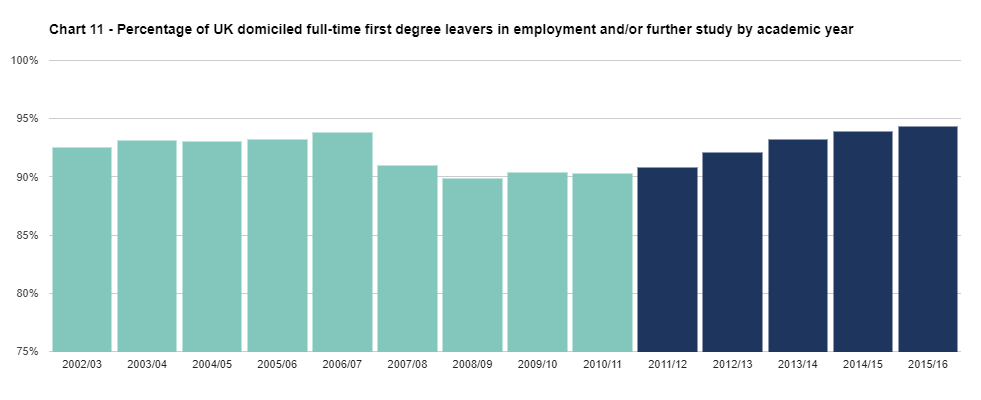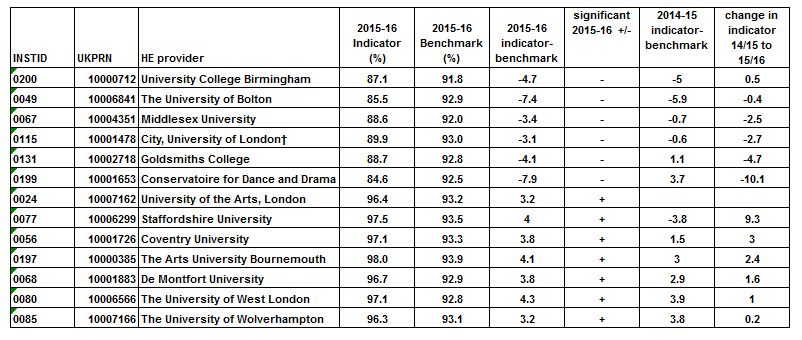Successful outcomes for students are often used as a proxy for institutional quality, hence the use of good degree outcomes, or value added, in league tables. The forthcoming Teaching Excellence Framework will almost certainly look at student outcomes as a measure also. However, not all students succeed equally, and we know from our own work at StaffsUni of the gaps in attainment between different groups of students.
The recent Green Paper, as well as highlighting the possible future TEF, indicates the government’s desire to see an increase in numbers of students from the most disadvantaged backgrounds as well as looking to ensure that all students can achieve.
In the light of this, last Monday I attended a HEFCE conference in London “Addressing differences in student outcomes: Developing strategic responses”, which looked at the findings of research into differential outcomes from Kings College London, and was an opportunity to hear from others in the sector on how they are tackling these issues.
Sessions attended were: the introduction by Chris Millward, Director of Policy at HEFCE; a presentation by Anna Mountford Zimnars of KCL; a session by Sorana Vieru and Malia Bouattia of NUS, and finally a session by Philip Plowden, DVC of University of Derby.
These are my notes of the day. Copies of the presentations can be viewed here.
Chris Millward HEFCE Director of Policy
Chris Milward started by considering where the government is on this agenda, linking the Green paper, the Treasury plan and plans from BIS.
Government wants to see a more diverse range of backgrounds in HE, in terms of entry, success and outcomes. For instance: double the number of students from disadvantaged backgrounds by 2020; an increase in the number of BME students by 20% by 2020, and to the sector to address differences in outcomes.
This means more responsibility for universities together with strengthened guidance to OFFA and the potential role of the Office for Students. There is an anticipated stronger role in quality assurance processes through the impact of TEF and the future need to measure difference in outcomes based on data and metrics agreed by government. This will lead to more targeted funding together with more emphasis on meeting obligations.
The HEFCE analysis shows an attainment gap for BME students, based on A-level analysis and the more that you add in other factors, the bigger the gaps become.
In addition, when looking at POLAR3 domicile, then there are further unexplained HE outcomes.
When considering students with disability, then the data suggests that those students who received DSA support perform above average, while those without perform less well.
On postgraduate progression, there is currently an unexplained difference in outcomes based on POLAR3 quintiles.
When considering employment and looking at the 40 month survey rather than the 6 month DLHE, all POLAR3 quintiles have worse outcomes than quintile 5 and for professional employment in particular. There are worse outcomes for students with disability, irrespective of DSA and there are worse employment outcomes for all categories of BME students and particularly in professional employment. Finally on gender, men perform worse overall on employment, but better in professional employment.
The HEFCE approaches to working on closing the gaps in outcomes include:
- National outreach programme
- Funding for disabled
- Supporting successful outcomes
- Catalyst fund
ANNA MOUNTFORD ZIMNARS – KCL
Dr Zimnars presented the outcomes of major piece of research into differential outcomes, which is available here.
“Access without success is no opportunity”
The research considered three questions:
- What is the pattern- empirical?
- How do we explain it – causal model?
- How do we change it effectively- policy and empirical?
The question was asked – “Do we need causality- if intervention works, does the causal model matter?”
Explained pattern of differential attainment using model that looked through a lens of macro/meso/micro levels and at experiences of preHE, HE and postHE.
4 explanatory dimensions were proposed:
- Curricula and learning
- Relationships -sense of belonging probably the most important factor
- Cultural, social and economic capital
- Psychosocial and identity factors
From the research, which involved asking questions of a large number of institutions, the level of awareness of the issue differed across institutions, although this may be changing now, possibly due to the proposals in TEF.
In terms of those institutions that tackled the differential outcomes issues the most successfully:
- Whole institution effect is most successful
- Need students academics and prof services working together
- Bottom up approaches with strategic support
- Universal and targeted interventions
Effective interventions were seen to be:
- Improvements to T&L
- Inclusive learning and curricula
- Deconstructing assessment
- Meaningful interactions
- Role models and mentoring
- Engagement with institution
- Generally few evaluations especially a lack of long term evaluations
Ended with 5 groups of recommendations
- Evidence base
- Raising awareness
- Embedding agenda
- Staff as change agents
- Students as change agents
Sorana Vieru and Malia Bouattia NUS
This presentation started from a previous NUS report, Race for Equality, and went on to look at a new NUS campaign on liberating the curriculum.
From previous NUS work, 42% of students said that the curriculum did not reflect their experiences particularly in history and philosophy. As well as looking at students as being in one particular demographic group, it was important to look at intersections between groups.
Work from NUS highlighted:
- 23% of black students described learning environment as cliquey
- Disabled students more dissatisfied in NSS
- 10% of trans students not willing to speak up in class
- Black students report lower levels of satisfaction on NSS on assessment and feedback
There was a focus on liberation-equality-diversity and the launch of a new campaign – “Liberate my Degree”. An online hub has been provided with resources for officers and reps with training resources to allow them to engage in debate in their institutions and to support becoming co-creators of curriculum.
Getting there – Helen Hathaway Philip Plowden
Speakers from University of Derby showed the pragmatic steps they have taken to challenge the gap in attainment between white and BME students.
In terms of background, the University has 28000 students, most of whom were state school sector. 20% of these self-identified as BME. The attainment gap was 24.6% in 2009-10. The impact of the work so far is the gap has closed to 12.4% in 14-15, although there was an increase in attainment across all areas this is a moving target.
Important thing is that there is no one single answer, so there was a need to stop looking and focus on the myriad interventions and see what impact they have.
- No magic bullet
- Post racial inclusive approach
- Suite of different strategies needed
Four main areas of interventions are used: Relationships, academic processes, psychological processes, and social capital.
The project at Derby explored data (down to module level) and relied on the regular Programme health checks which used a digest of metrics including attainment by ethnicity. In these, the DVC meets with programme leads to engage with course teams at chalk face. Areas covered include: outcomes, finances reliance on clearing, and staff numbers. In particular the programme health checks looked at “spiky” degree profiles- looking at individual modules and gaps, not with an intention to play a blame game but to ask what is going right and ask others to consider that.
To support interventions, Derby developed PReSS- practical recipes for student success whch contains evaluations and case studies and can be used from: Http://uodpress.wordpress.com
The key lessons learned were:
- No simple solution. Paralysis by analysis. Just have to crack on and do what works.
- Learn from others
- Post racial inclusive approach. Difficult to reconcile this with some of the morning’s talk. Is this unduly dismissive of liberation approaches
- Importance of communication -degree of profile. But once in the mainstream it might get lost.
- Need consistent way to measure attainment gap.
- Important to evaluate interventions.
Points from Discussions
A lively discussion followed, and the following are just snippets of some of the topics – in some cases these reflect discussion we have had in our own institution, but I add them in almost as provocations for further debate.
- Is there a threat to academic staff when we discuss this BME and other attainment gaps? A danger of appearing accusatory?
- Why are there difference between subjects such as business and nursing – do cohorts have an impact? Why do the subjects with the smallest attainment gaps want to engage in the debate the most?
- How do we check who uses the resources to support inclusive learning, and should we check?
- How do you liberate the curriculum and how do we re-educate staff to draw on a wider range of ideas, since they are a product of their own subject and environment?
- What about the Attainment gap for students who live at home where home life and working gets in the way of study?
Conclusions
In all, a thought provoking day. A lot of emphasis, as always on the BME attainment gap, but also more opportunity to explore attainment more generally and to recognise how this agenda will become increasingly important post-TEF.
In terms of what we could do next, then as we develop better internal metrics of modules and courses, we can start to see how we can use this information to understand better the outcomes that our students achieve. Linking this to revisions in the way in which we review our courses, both from a quality assurance and enhancement perspective, as well as a more data-centric health check would provide the opportunity to have the right discussions, to ensure that we maximise the opportunities for our students to be successful.






